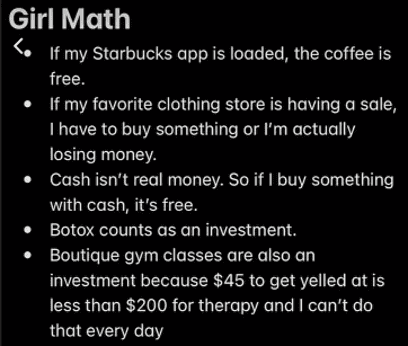By Kate O’Loughlin, associate strategy director at Rufus Powered by Initiative
Today I bought a $300 dress and made $100. No, I didn’t have to sell anything – but the dress was on sale which means I literally MADE money off my purchase… thank you #girlmath.
If you haven’t experienced or heard of Girl Math by now, then prepare to spend some cash.
Girl Math is the trend of rationalising and justifying purchases based off an intricate web of perspectives … as seen per the hyperlinks.

According to the current cultural narrative, spending is in crisis mode and spend data is showing consumers are spending less on necessary purchases like groceries. #girlmath on the other hand, is emerging as the antidote to financial sacrifice. Armed with an arsenal of psychological reframes, shoppers willingly investing in frivolous (and sometimes costly) items…guilt-free. Girl Math is the lipstick effect in full swing but rebooted and rebranded on TikTok.
#girlmath is the counter-cultural reaction to the recession, and whilst some call it irresponsible others call it liberating… after all, how much worse can it get?
So, what does Girl Math say about how consumers are actually approaching spending habits and what does this mean for brands and marketers?

1. The culture of ‘a little treat’.
Be it a 5-pack to a fancy pilates class or an iced VoVo artisanal cookie, ‘little treat’ purchases are easily justified in the name of helping one’s mental health. The proliferation of self-care during the last decade has given shoppers a behaviour to easily default back to during times of stress. With the ever-increasing news cycle of doom that’s only been made worse due to cost of living, ‘little treats’ have become an increasingly common investment as evidenced through Girl Math content. To feed into the ‘little treat’ trend, retailers or CPG brands should look to amplify products or promotions that align to self-indulgence.
2. Give a little, get a little.
Free shipping is a bargain in Girl Math culture… let alone a gift with purchase – that’s practically MAKING money! While it might not seemingly make sense, behavioural science would suggest that compartmentalising a habit is a logical occurrence. Compartmentalising shopping into ‘free’ versus ‘not free’ is a way for online customers to rationalise spending more than initially expected, as the perceived value of the ‘free’ product outweighs the increased investment to achieve it. Personally, my $80 investment on a shampoo is 100% worth it when I get my free sample and TimTam thanks to Adore Beauty.
In a time when parting with any form of income induces a minor guilt-ridden panic, the inclusion of consumer rewards has never been more important. Brands should look to offer more free shipping opportunities or incentivise spends with gift with purchase offers.
3. We can’t afford a house anyway…
The speed at which Gen Z has accepted and run with Girl Math is an indication of the “fu*k it” mentality the demographic takes towards saving for the traditional martyr of success… home ownership. It’s no surprise that the current housing market and renting crisis is the worst it’s ever been, and the rise of Girl Math is simply one example of how Gen Z are giving up on trying. There is more immediate value in justifying the instant gratification of a purchase to help cope with the existential hellhole that is the current political/climate/economic crisis (see point one) than there is in saving for a home.
Brands should not look to capitalise on this behaviour but instead, empathise. Leaning into brand marketing to foster emotionally charged customer relationships gives young shoppers a moment of respite while also providing an opportunity to grow brand meaning.
In summary, a little spending never hurt anybody… or at least so Girl Math would suggest.
Creating and identifying ways to surprise and delight consumers has never been so important, and the learnings from Girl Math present the perfect case study to do so.
–
Top image: Kate O’Loughlin

